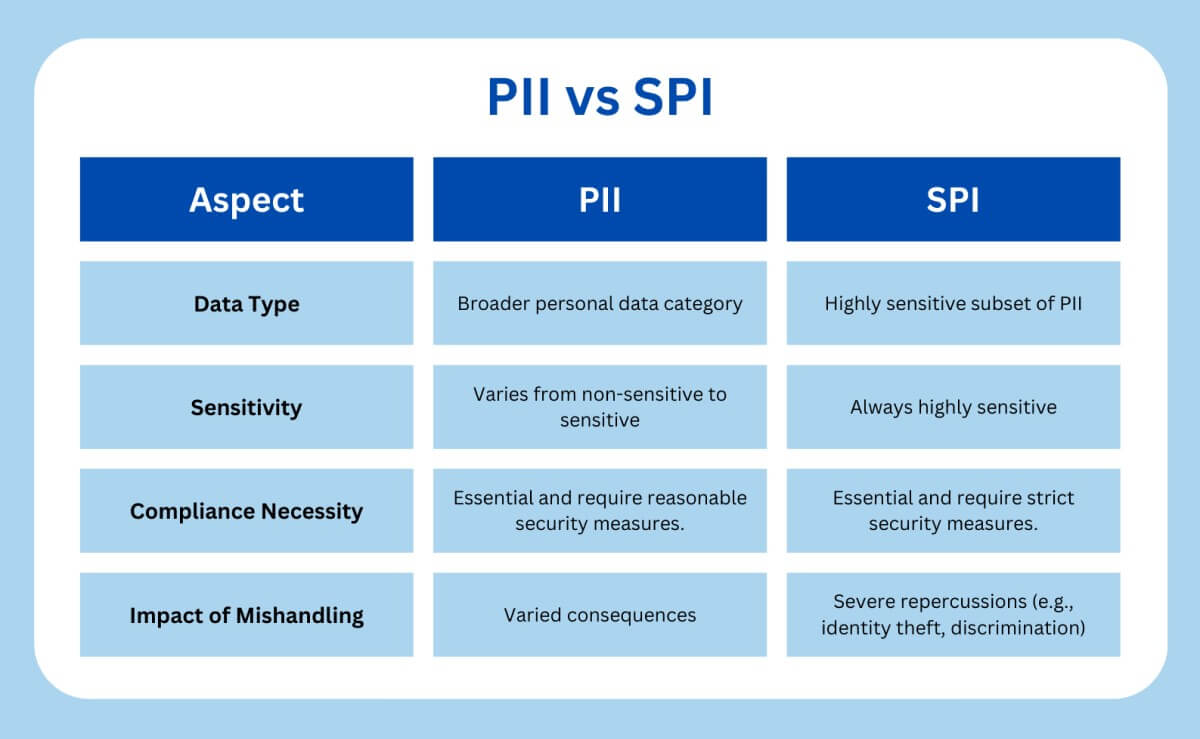With the increasing threat of cyber attacks, protecting personal and sensitive data has become one of the main priorities of modern organizations. As a result, organizations have opted to use PII and SPI concepts to improve data protection and regulatory compliance. This article will explain PII and SPI and the differences between them.
What is PII?
PII (personally identifiable information) is any information that can be used to identify a person on its own or in conjunction with other information. PII is divided into two categories based on its sensitivity: sensitive PII and non-sensitive PII.

Sensitive PII
Sensitive PII is any information that can be used to uniquely identify a person. This information usually only belongs to a single person. Social security numbers, tax identification numbers, bank account numbers, driver’s licenses, and biometric data are common examples of sensitive PII.
Non-sensitive PII
Non-sensitive PII is information that does not directly identify a person on its own but can be linked with other information to identify them. It cannot be used alone since two or more persons may possess the same information. Examples of non-sensitive PII include name, date or place of birth, gender or race, and email address.
What is SPI?
SPI, or sensitive personal information, is a subcategory of personally identifiable information that can be used to directly identify a person. Unlike PII, SPI only includes sensitive data like health records, financial data, and social security numbers. Hence, disclosing them can put a considerable risk to a person’s identity and safety.

The definition of SPI can differ depending on the data protection regulation you follow. This difference affects how you need to handle, store, and protect SPI.
The GDPR on SPI
The EU’s General Data Protection Regulation (GDPR) refers to personal information as Special Categories of Personal Data. According to the Article 9(1), GDPR considers the following personal data as sensitive information:
- Fingerprint, DNA, and other biometric information.
- Data concerning a person’s ethnic or racial origin.
- Information on how a person thinks (politically, religiously, or philosophically).
- Data that concern someone’s sex life or sexual orientation.
- Health information.
- Trade-union memberships.
The CPRA on SPI
The California Privacy Rights Act (CPRA) uses the term Sensitive Personal Information to define personal information. According to the section 1798.140(o)(1), CPRA considers the following personal data as sensitive information:
- Personal identifiers like social security, driver’s license, and passport numbers.
- Genetic data.
- Financial information.
- Precise geolocation.
- Racial or ethnic origins.
- Religious or philosophical beliefs.
- Union membership.
- Contents of private communications like mail, email, and text messages.
PII vs. SPI
PII and SPI are two important concepts in personal data protection. Hence, it is essential to understand their similarities and differences to manage personal information effectively.

1. Data Type
Both PII and SPI involve managing personal data. However, SPI includes only specific information that, by itself, can be used to uniquely identify a person. On the other hand, PII includes information that can be used either alone or in combination to identify a person.
2. Sensitivity
SPI is considered highly sensitive since it contains information unique to a single person. Exposing SPI to an attacker can cause significant privacy and safety concerns as it can be used to identify an individual directly.
PII is less sensitive than SPI because it also contains non-sensitive data. Non-sensitive data is often publicly available and cannot be used alone to correctly identify an individual.
3. Compliance
Both PII and SPI are governed under strict compliance regulations, but the specific requirements and implications differ due to their sensitivity levels. For example, SPI compliance requires security measures like encryption, documentation on how SPI is collected, used, and shared, and frequent audits to ensure adherence to privacy laws like GDPR or HIPAA.
On the other hand, PII compliance requirements are less strict. Here, the main focus should be ensuring all personal data is handled lawfully and transparently, with reasonable security measures.
4. Impact of Mishandling
Failure to handle both SPI and PII may lead to serious issues such as data leakage, financial loss, identity theft, and loss of reputation. However, the outcome of poor handling of SPI is much worse because it deals with highly sensitive data such as health information, financial information, and social security numbers.
Conclusion
PII and SPI are two essential concepts in data management that ensure an individual’s security and privacy. PII contains both highly sensitive and less sensitive data, whereas SPI only applies to highly sensitive data. Organizations must understand these different types of information to protect personal data and meet the legal requirements of data protection.